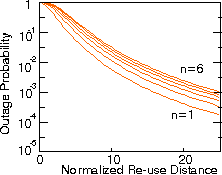|
Outage Probability in Cellular Network |
||
 |
||
|
|
A crucial aspect in the evaluation and planning of radio networks is the computation of the effect of co-channel interference in radio links. The amount of interference that can be tolerated determines the required separation distance between co-channel cells and therefore also the efficiency of the network.
The link performance of cellular telephone networks was first studied around 1980 by Gosling, French and Cox. Initial analyses were limited to outage probabilities in continuous wave (CW) voice communication, taking into account path loss and flat (frequency non-selective) Rayleigh fading. In the 1980's the technique for computing outage probabilities was refined step by step, considering among other things shadowing, multiple interfering signals cumulating coherently or, more realistically, incoherently, the modulation technique and error correction method, and more recently the presence of a dominant line-of-sight propagation path, as it occurs in micro-cellular networks. The stochastic occupation of nearby co-channel cells according to the traffic laws by Erlang was included in some studies. Approximate techniques have been used to incorporate the effect of the various aspects.
Linnartz was the first to report a mathematicaly exact method to calculate outage probabilities. In particular the use of Laplace Transforms of probability densities of received signal power proved very effective.
|
Outage Probability in Cellular Network |
||
 |
||
|
|
This Embedded Calculator considers Rayleigh fading, shadowing, discontinuous transmission, man made (burst or impulsive) noise and multipath self interference (intersymbol interference). The internal calculation method is based on Linnartz' method of Laplace images of pdf's of interference power.
| Telelearning | ||
| A tutorial on the underlying mathematical methods: animated audio (embedded SMIL) | ||
| More tutorials |